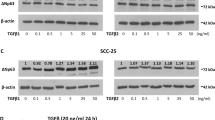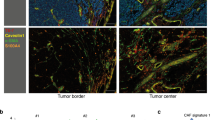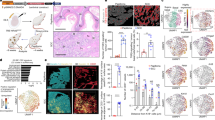Abstract
The membrane-anchored serine protease, matriptase, is consistently dysregulated in a range of human carcinomas, and high matriptase activity correlates with poor prognosis. Furthermore, matriptase is unique among tumor-associated proteases in that epithelial stem cell expression of the protease suffices to induce malignant transformation. Here, we use genetic epistasis analysis to identify proteinase-activated receptor (PAR)-2-dependent inflammatory signaling as an essential component of matriptase-mediated oncogenesis. In cell-based assays, matriptase was a potent activator of PAR-2, and PAR-2 activation by matriptase caused robust induction of nuclear factor (NF)κB through Gαi. Importantly, genetic elimination of PAR-2 from mice completely prevented matriptase-induced pre-malignant progression, including inflammatory cytokine production, inflammatory cell recruitment, epidermal hyperplasia and dermal fibrosis. Selective ablation of PAR-2 from bone marrow-derived cells did not prevent matriptase-driven pre-malignant progression, indicating that matriptase activates keratinocyte stem cell PAR-2 to elicit its pro-inflammatory and pro-tumorigenic effects. When combined with previous studies, our data suggest that dual induction of PAR-2-NFκB inflammatory signaling and PI3K-Akt-mTor survival/proliferative signaling underlies the transforming potential of matriptase and may contribute to pro-tumorigenic signaling in human epithelial carcinogenesis.
This is a preview of subscription content, access via your institution
Access options
Subscribe to this journal
Receive 50 print issues and online access
$259.00 per year
only $5.18 per issue
Buy this article
- Purchase on Springer Link
- Instant access to full article PDF
Prices may be subject to local taxes which are calculated during checkout






Similar content being viewed by others
References
Lopez-Otin C, Hunter T . The regulatory crosstalk between kinases and proteases in cancer. Nat Rev Cancer 2010; 10: 278–292.
Benaud C, Oberst M, Hobson JP, Spiegel S, Dickson RB, Lin CY . Sphingosine 1-phosphate, present in serum-derived lipoproteins, activates matriptase. J Biol Chem 2002; 277: 10539–10546.
Hoang CD, D'Cunha J, Kratzke MG, Casmey CE, Frizelle SP, Maddaus MA et al. Gene expression profiling identifies matriptase overexpression in malignant mesothelioma. Chest 2004; 125: 1843–1852.
Jin JS, Chen A, Hsieh DS, Yao CW, Cheng MF, Lin YF . Expression of serine protease matriptase in renal cell carcinoma: correlation of tissue microarray immunohistochemical expression analysis results with clinicopathological parameters. Int J Surg Pathol 2006; 14: 65–72.
Jin JS, Hsieh DS, Loh SH, Chen A, Yao CW, Yen CY . Increasing expression of serine protease matriptase in ovarian tumors: tissue microarray analysis of immunostaining score with clinicopathological parameters. Mod Pathol 2006; 19: 447–452.
Johnson MD, Oberst MD, Lin CY, Dickson RB . Possible role of matriptase in the diagnosis of ovarian cancer. Expert Rev Mol Diagn 2003; 3: 331–338.
Kang JY, Dolled-Filhart M, Ocal IT, Singh B, Lin CY, Dickson RB et al. Tissue microarray analysis of hepatocyte growth factor/Met pathway components reveals a role for Met, matriptase, and hepatocyte growth factor activator inhibitor 1 in the progression of node-negative breast cancer. Cancer Res 2003; 63: 1101–1105.
Lee JW, Yong Song S, Choi JJ, Lee SJ, Kim BG, Park CS et al. Increased expression of matriptase is associated with histopathologic grades of cervical neoplasia. Hum Pathol 2005; 36: 626–633.
Oberst M, Anders J, Xie B, Singh B, Ossandon M, Johnson M et al. Matriptase and HAI-1 are expressed by normal and malignant epithelial cells in vitro and in vivo. Am J Pathol 2001; 158: 1301–1311.
Oberst MD, Johnson MD, Dickson RB, Lin CY, Singh B, Stewart M et al. Expression of the serine protease matriptase and its inhibitor HAI-1 in epithelial ovarian cancer: correlation with clinical outcome and tumor clinicopathological parameters. Clin Cancer Res 2002; 8: 1101–1107.
Tanimoto H, Shigemasa K, Tian X, Gu L, Beard JB, Sawasaki T et al. Transmembrane serine protease TADG-15 (ST14/Matriptase/MT-SP1): expression and prognostic value in ovarian cancer. Br J Cancer 2005; 92: 278–283.
Vogel LK, Saebo M, Skjelbred CF, Abell K, Pedersen ED, Vogel U et al. The ratio of Matriptase/HAI-1 mRNA is higher in colorectal cancer adenomas and carcinomas than corresponding tissue from control individuals. BMC Cancer 2006; 6: 176.
Szabo R, Rasmussen AL, Moyer AB, Kosa P, Schafer J, Molinolo A et al. c-Met-induced epithelial carcinogenesis is initiated by the serine protease matriptase. Oncogene 2011; 30: 2003–2016.
Lebeau AM, Lee M, Murphy ST, Hann BC, Warren RS, Delos Santos R et al. Imaging a functional tumorigenic biomarker in the transformed epithelium. Proc Natl Acad Sci USA 2013; 110: 93–98.
Bocheva G, Rattenholl A, Kempkes C, Goerge T, Lin CY, D'Andrea MR et al. Role of matriptase and proteinase-activated receptor-2 in nonmelanoma skin cancer. J Invest Dermatol 2009; 129: 1816–1823.
List K . Matriptase: a culprit in cancer? Future Oncol 2009; 5: 97–104.
Bugge TH, Antalis TM, Wu Q . Type II transmembrane serine proteases. J Biol Chem 2009; 284: 23177–23181.
List K, Szabo R, Molinolo A, Nielsen BS, Bugge TH . Delineation of matriptase protein expression by enzymatic gene trapping suggests diverging roles in barrier function, hair formation, and squamous cell carcinogenesis. Am J Pathol 2006; 168: 1513–1525.
List K, Szabo R, Molinolo A, Sriuranpong V, Redeye V, Murdock T et al. Deregulated matriptase causes ras-independent multistage carcinogenesis and promotes ras-mediated malignant transformation. Genes Dev 2005; 19: 1934–1950.
Schaffner F, Ruf W . Tissue factor and protease-activated receptor signaling in cancer. Semin Thromb Hemost 2008; 34: 147–153.
Camerer E, Barker A, Duong DN, Ganesan R, Kataoka H, Cornelissen I et al. Local protease signaling contributes to neural tube closure in the mouse embryo. Dev Cell 2010; 18: 25–38.
Coughlin SR, Camerer E . Participation in inflammation. J Clin Invest 2003; 111: 25–27.
Rothmeier AS, Ruf W . Protease-activated receptor 2 signaling in inflammation. Semin Immunopathol 34: 133–149.
Nystedt S, Emilsson K, Wahlestedt C, Sundelin J . Molecular cloning of a potential proteinase activated receptor. Proc Natl Acad Sci USA 1994; 91: 9208–9212.
Camerer E, Huang W, Coughlin SR . Tissue factor- and factor X-dependent activation of protease-activated receptor 2 by factor VIIa. Proc Natl Acad Sci USA 2000; 97: 5255–5260.
Camerer E, Rottingen JA, Iversen JG, Prydz H . Coagulation factors VII and X induce Ca2+ oscillations in Madin-Darby canine kidney cells only when proteolytically active. J Biol Chem 1996; 271: 29034–29042.
Camerer E, Kataoka H, Kahn M, Lease K, Coughlin SR . Genetic evidence that protease-activated receptors mediate factor Xa signaling in endothelial cells. J Biol Chem 2002; 277: 16081–16087.
Molino M, Barnathan ES, Numerof R, Clark J, Dreyer M, Cumashi A et al. Interactions of mast cell tryptase with thrombin receptors and PAR-2. J Biol Chem 1997; 272: 4043–4049.
Oikonomopoulou K, Hansen KK, Saifeddine M, Tea I, Blaber M, Blaber SI et al. Proteinase-activated receptors, targets for kallikrein signaling. J Biol Chem 2006; 281: 32095–32112.
Ramsay AJ, Dong Y, Hunt ML, Linn M, Samaratunga H, Clements JA et al. Kallikrein-related peptidase 4 (KLK4) initiates intracellular signaling via protease-activated receptors (PARs). KLK4 and PAR-2 are co-expressed during prostate cancer progression. J Biol Chem 2008; 283: 12293–12304.
Chokki M, Yamamura S, Eguchi H, Masegi T, Horiuchi H, Tanabe H et al. Human airway trypsin-like protease increases mucin gene expression in airway epithelial cells. Am J Respir Cell Mol Biol 2004; 30: 470–478.
Wilson S, Greer B, Hooper J, Zijlstra A, Walker B, Quigley J et al. The membrane-anchored serine protease, TMPRSS2, activates PAR-2 in prostate cancer cells. Biochem J 2005; 388: 967–972.
Takeuchi T, Harris JL, Huang W, Yan KW, Coughlin SR, Craik CS . Cellular localization of membrane-type serine protease 1 and identification of protease-activated receptor-2 and single-chain urokinase-type plasminogen activator as substrates. J Biol Chem 2000; 275: 26333–26342.
Santulli RJ, Derian CK, Darrow AL, Tomko KA, Eckardt AJ, Seiberg M et al. Evidence for the presence of a protease-activated receptor distinct from the thrombin receptor in human keratinocytes. Proc Natl Acad Sci USA 1995; 92: 9151–9155.
Hou L, Kapas S, Cruchley AT, Macey MG, Harriott P, Chinni C et al. Immunolocalization of protease-activated receptor-2 in skin: receptor activation stimulates interleukin-8 secretion by keratinocytes in vitro. Immunology 1998; 94: 356–362.
Scott G, Leopardi S, Parker L, Babiarz L, Seiberg M, Han R . The proteinase-activated receptor-2 mediates phagocytosis in a Rho-dependent manner in human keratinocytes. J Invest Dermatol 2003; 121: 529–541.
Kanke T, Macfarlane SR, Seatter MJ, Davenport E, Paul A, McKenzie RC et al. Proteinase-activated receptor-2-mediated activation of stress-activated protein kinases and inhibitory kappa B kinases in NCTC 2544 keratinocytes. J Biol Chem 2001; 276: 31657–31666.
Wakita H, Furukawa F, Takigawa M . Thrombin and trypsin induce granulocyte-macrophage colony-stimulating factor and interleukin-6 gene expression in cultured normal human keratinocytes. Proc Assoc Am Physicians 1997; 109: 190–207.
Briot A, Deraison C, Lacroix M, Bonnart C, Robin A, Besson C et al. Kallikrein 5 induces atopic dermatitis-like lesions through PAR2-mediated thymic stromal lymphopoietin expression in Netherton syndrome. J Exp Med 2009; 206: 1135–1147.
Scott G, Leopardi S, Printup S, Malhi N, Seiberg M, Lapoint R . Proteinase-activated receptor-2 stimulates prostaglandin production in keratinocytes: analysis of prostaglandin receptors on human melanocytes and effects of PGE2 and PGF2alpha on melanocyte dendricity. J Invest Dermatol 2004; 122: 1214–1224.
Buddenkotte J, Stroh C, Engels IH, Moormann C, Shpacovitch VM, Seeliger S et al. Agonists of proteinase-activated receptor-2 stimulate upregulation of intercellular cell adhesion molecule-1 in primary human keratinocytes via activation of NF-kappa B. J Invest Dermatol 2005; 124: 38–45.
Frateschi S, Camerer E, Crisante G, Rieser S, Membrez M, Charles RP et al. PAR2 absence completely rescues inflammation and ichthyosis caused by altered CAP1/Prss8 expression in mouse skin. Nat Commun 2011; 2: 161.
Lindner JR, Kahn ML, Coughlin SR, Sambrano GR, Schauble E, Bernstein D et al. Delayed onset of inflammation in protease-activated receptor-2- deficient mice. J Immunol 2000; 165: 6504–6510.
Perez-Moreno M, Davis MA, Wong E, Pasolli HA, Reynolds AB, Fuchs E . p120-catenin mediates inflammatory responses in the skin. Cell 2006; 124: 631–644.
Cataisson C, Salcedo R, Hakim S, Moffitt BA, Wright L, Yi M et al. IL-1R-MyD88 signaling in keratinocyte transformation and carcinogenesis. J Exp Med 2012; 209: 1689–1702.
Szabo R, Uzzun Sales K, Kosa P, Shylo NA, Godiksen S, Hansen KK et al. Reduced prostasin (CAP1/PRSS8) activity eliminates HAI-1 and HAI-2 deficiency-associated developmental defects by preventing matriptase activation. PLoS Genet 2012; 8: e1002937.
Friis S, Sales KU, Godiksen S, Peters DE, Lin CY, Vogel LK et al. A matriptase-prostasin reciprocal zymogen activation complex with unique features: prostasin as a non-enzymatic co-factor for matriptase activation. J Biol Chem 2013; 288: 19028–19039.
Seitz I, Hess S, Schulz H, Eckl R, Busch G, Montens HP et al. Membrane-type serine protease-1/matriptase induces interleukin-6 and -8 in endothelial cells by activation of protease-activated receptor-2: potential implications in atherosclerosis. Arterioscler Thromb Vasc Biol 2007; 27: 769–775.
Kaufmann R, Oettel C, Horn A, Halbhuber KJ, Eitner A, Krieg R et al. Met receptor tyrosine kinase transactivation is involved in proteinase-activated receptor-2-mediated hepatocellular carcinoma cell invasion. Carcinogenesis 2009; 30: 1487–1496.
Schmidlin F, Amadesi S, Dabbagh K, Lewis DE, Knott P, Bunnett NW et al. Protease-activated receptor 2 mediates eosinophil infiltration and hyperreactivity in allergic inflammation of the airway. J Immunol 2002; 169: 5315–5321.
Szabo R, Hobson JP, List K, Molinolo A, Lin CY, Bugge TH . Potent inhibition and global co-localization implicate the transmembrane Kunitz-type serine protease inhibitor hepatocyte growth factor activator inhibitor-2 in the regulation of epithelial matriptase activity. J Biol Chem 2008; 283: 29495–29504.
Acknowledgements
We thank Dr Mary Jo Danton for critically reviewing this manuscript. Histology was performed by Histoserv, Germantown, MD, USA. We thank Dr Allessia Gallo, Shyh-Ing Jang, Colleen Doci, Patricia Pilla, Zhiyong Wang, Canstantinos Mikelis, Ramiro Iglesias-Bartolome and Morgan O’Hare for technical assistance. The study was supported by the NIDCR Intramural Research Program (THB, JSG, WC), the Augustinus Foundation, Kobmand Kristian Kjær og hustrus Foundation, the Kjær-Foundation, the Dagmar Marshalls Foundation, the Snedkermester Sophus Jacobsen og Hustru Astrid Jacobsens Foundation, the Grosserer Valdemar Foersom og Hustru Thyra Foersoms Foundation and Fabrikant Einar Willumsens Mindelegat (SG and LKV), and the Sao Paulo Research Foundation (FAPESP) (MH, SRR).
Author information
Authors and Affiliations
Corresponding author
Ethics declarations
Competing interests
The authors declare no conflict of interest.
Additional information
Supplementary Information accompanies this paper on the Oncogene website
Rights and permissions
About this article
Cite this article
Sales, K., Friis, S., Konkel, J. et al. Non-hematopoietic PAR-2 is essential for matriptase-driven pre-malignant progression and potentiation of ras-mediated squamous cell carcinogenesis. Oncogene 34, 346–356 (2015). https://doi.org/10.1038/onc.2013.563
Received:
Revised:
Accepted:
Published:
Issue Date:
DOI: https://doi.org/10.1038/onc.2013.563
Keywords
This article is cited by
-
Intramembrane proteolysis of an extracellular serine protease, epithin/PRSS14, enables its intracellular nuclear function
BMC Biology (2020)
-
Protease-activated receptors (PARs): mechanisms of action and potential therapeutic modulators in PAR-driven inflammatory diseases
Thrombosis Journal (2019)
-
Tracking genome-editing and associated molecular perturbations by SWATH mass spectrometry
Scientific Reports (2019)
-
Anti-cancer activity of the novel 2-hydroxydiarylamide derivatives IMD-0354 and KRT1853 through suppression of cancer cell invasion, proliferation, and survival mediated by TMPRSS4
Scientific Reports (2019)
-
Cell surface–anchored serine proteases in cancer progression and metastasis
Cancer and Metastasis Reviews (2019)



